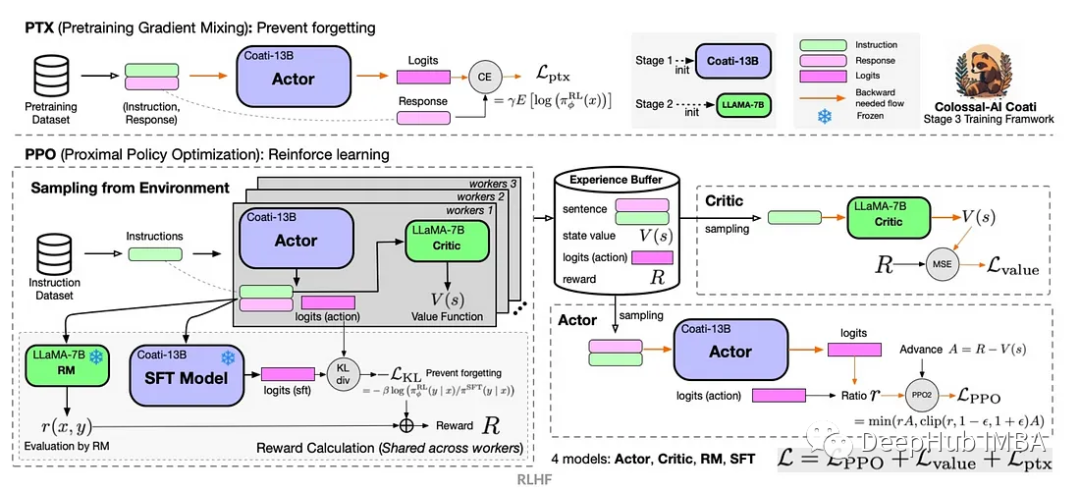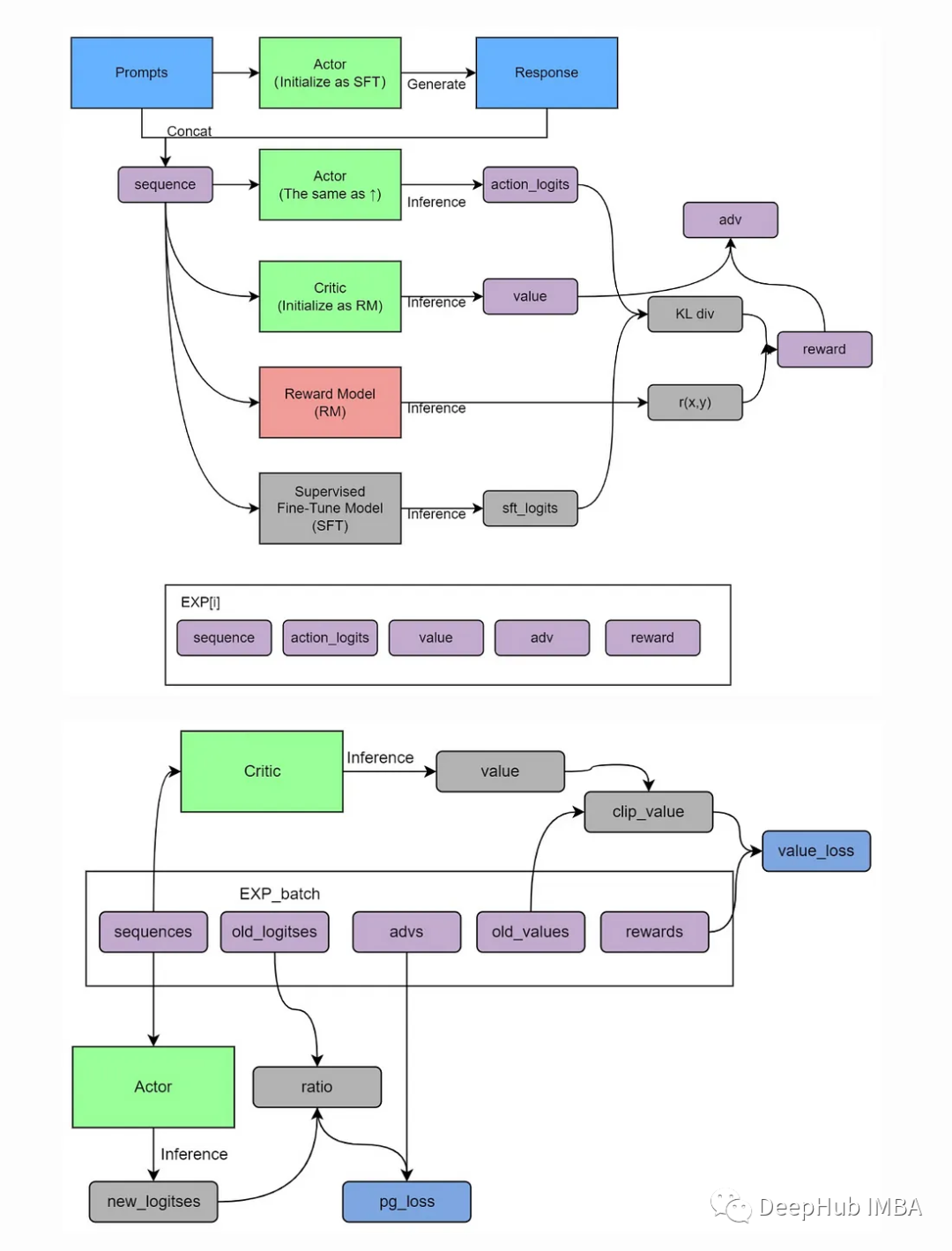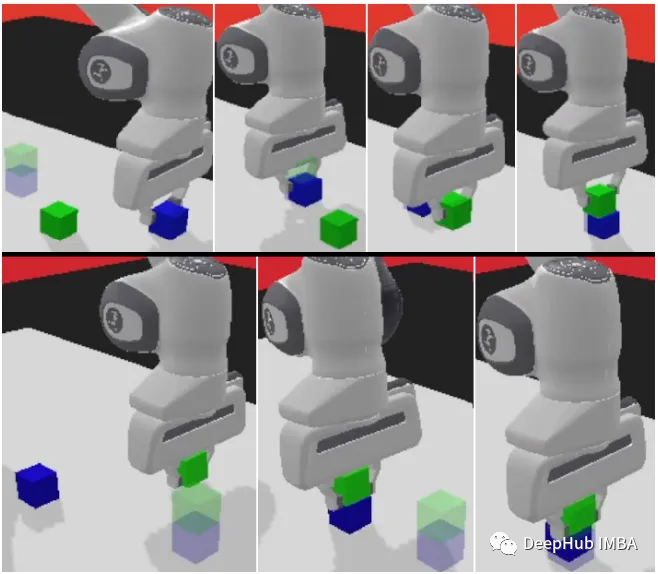 Technology peripherals
Technology peripherals
 AI
AI
 Deep Q-learning reinforcement learning using Panda-Gym's robotic arm simulation
Deep Q-learning reinforcement learning using Panda-Gym's robotic arm simulation
Deep Q-learning reinforcement learning using Panda-Gym's robotic arm simulation
Reinforcement learning (RL) is a machine learning method that allows an agent to learn how to behave in its environment through trial and error. Agents are rewarded or punished for taking actions that lead to desired outcomes. Over time, the agent learns to take actions that maximize its expected reward

RL agents typically use a Markov decision process ( MDP), a mathematical framework for modeling sequential decision problems. MDP consists of four parts:
- #State: A set of possible states of the environment.
- Action: A set of actions that an agent can take.
- Transition function: A function that predicts the probability of transitioning to a new state given the current state and action.
- Reward function: A function that assigns a reward to the agent for each conversion.
The goal of the agent is to learn a policy function that maps states to actions. Maximize the agent's expected return over time through a policy function.
Deep Q-learning is a reinforcement learning algorithm that uses deep neural networks to learn policy functions. Deep neural networks take the current state as input and output a vector of values, where each value represents a possible action. The agent then takes the action based on the highest value
Deep Q-learning is a value-based reinforcement learning algorithm, which means it learns the value of each state-action pair. The value of a state-action pair is the expected reward for the agent to take that action in that state.
Actor-Critic is a RL algorithm that combines value-based and policy-based. There are two components:
#Actor: The actor is responsible for selecting operations.
Critic: Responsible for evaluating the Actor's behavior.
Actors and critics are trained at the same time. Actors are trained to maximize expected rewards and critics are trained to accurately predict expected rewards for each state-action pair
The Actor-Critic algorithm has several advantages over other reinforcement learning algorithms advantage. First, it is more stable, which means that bias is less likely to occur during training. Second, it's more efficient, which means it can learn faster. Third, it has better scalability and can be applied to problems with large state and operation spaces
The table below summarizes the differences between Deep Q-learning and Actor-Critic The main differences:

Advantages of Actor-Critic (A2C)
Actor-Critic is A popular reinforcement learning architecture that combines policy-based and value-based approaches. It has many advantages that make it a strong choice for solving various reinforcement learning tasks:
1. Low variance
Compared Compared to traditional policy gradient methods, A2C usually has lower variance during training. This is because A2C uses both the policy gradient and the value function, and uses the value function to reduce variance in the calculation of the gradient. Low variance means that the training process is more stable and can converge to a better strategy faster
2. Faster learning speed
Due to Due to the low variance feature, A2C can usually learn a good strategy faster. This is especially important for tasks that require extensive simulations, as faster learning speeds save valuable time and computing resources.
3. Combining policy and value function
One of the distinctive features of A2C is that it learns policy and value function simultaneously. This combination enables the agent to better understand the correlation between environment and actions, thereby better guiding policy improvements. The existence of the value function also helps reduce errors in policy optimization and improve training efficiency.
4. Supports continuous and discrete action spaces
A2C can adapt to different types of action spaces, including continuous and discrete actions, and is very versatile . This makes A2C a widely applicable reinforcement learning algorithm that can be applied to a variety of tasks, from robot control to gameplay optimization
5. Parallel training
A2C can be easily parallelized to take full advantage of multi-core processors and distributed computing resources. This means more empirical data can be collected in less time, thus improving training efficiency.
Although Actor-Critic methods have some advantages, they also face some challenges, such as hyperparameter tuning and potential instability in training. However, with appropriate tuning and techniques such as experience replay and target networks, these challenges can be mitigated to a large extent, making Actor-Critic a valuable approach in reinforcement learning

panda-gym
##panda-gym is developed based on the PyBullet engine and encapsulates reach, push, slide, Six tasks including pick&place, stack, and flip are mainly inspired by OpenAI Fetch.

We will use panda-gym as an example to show the following code
1. Installation library
First, we need to initialize the code of the reinforcement learning environment:
!apt-get install -y \libgl1-mesa-dev \libgl1-mesa-glx \libglew-dev \xvfb \libosmesa6-dev \software-properties-common \patchelf !pip install \free-mujoco-py \pytorch-lightning \optuna \pyvirtualdisplay \PyOpenGL \PyOpenGL-accelerate\stable-baselines3[extra] \gymnasium \huggingface_sb3 \huggingface_hub \ panda_gym
2. Import libraryimport os import gymnasium as gym import panda_gym from huggingface_sb3 import load_from_hub, package_to_hub from stable_baselines3 import A2C from stable_baselines3.common.evaluation import evaluate_policy from stable_baselines3.common.vec_env import DummyVecEnv, VecNormalize from stable_baselines3.common.env_util import make_vec_env
Copy after login
import os import gymnasium as gym import panda_gym from huggingface_sb3 import load_from_hub, package_to_hub from stable_baselines3 import A2C from stable_baselines3.common.evaluation import evaluate_policy from stable_baselines3.common.vec_env import DummyVecEnv, VecNormalize from stable_baselines3.common.env_util import make_vec_env
3. Create a running environmentenv_id = "PandaReachDense-v3" # Create the env env = gym.make(env_id) # Get the state space and action space s_size = env.observation_space.shape a_size = env.action_space print("\n _____ACTION SPACE_____ \n") print("The Action Space is: ", a_size) print("Action Space Sample", env.action_space.sample()) # Take a random actionCopy after login
env_id = "PandaReachDense-v3" # Create the env env = gym.make(env_id) # Get the state space and action space s_size = env.observation_space.shape a_size = env.action_space print("\n _____ACTION SPACE_____ \n") print("The Action Space is: ", a_size) print("Action Space Sample", env.action_space.sample()) # Take a random action4. Standardization of observations and rewards
A good way to optimize reinforcement learning is to optimize the input Features are normalized. We calculate the running mean and standard deviation of the input features through the wrapper. At the same time, the reward is normalized by adding norm_reward = True
env = make_vec_env(env_id, n_envs=4) env = VecNormalize(env, norm_obs=True, norm_reward=True, clip_obs=10.)
5, creating an A2C model
We use the official model trained by the Stable-Baselines3 team Agent
model = A2C(policy = "MultiInputPolicy",env = env,verbose=1)
6, Training A2Cmodel.learn(1_000_000) # Save the model and VecNormalize statistics when saving the agent model.save("a2c-PandaReachDense-v3") env.save("vec_normalize.pkl")Copy after login
model.learn(1_000_000) # Save the model and VecNormalize statistics when saving the agent model.save("a2c-PandaReachDense-v3") env.save("vec_normalize.pkl")7, Evaluating agentfrom stable_baselines3.common.vec_env import DummyVecEnv, VecNormalize # Load the saved statistics eval_env = DummyVecEnv([lambda: gym.make("PandaReachDense-v3")]) eval_env = VecNormalize.load("vec_normalize.pkl", eval_env) # We need to override the render_mode eval_env.render_mode = "rgb_array" # do not update them at test time eval_env.training = False # reward normalization is not needed at test time eval_env.norm_reward = False # Load the agent model = A2C.load("a2c-PandaReachDense-v3") mean_reward, std_reward = evaluate_policy(model, eval_env) print(f"Mean reward = {mean_reward:.2f} +/- {std_reward:.2f}")Copy after login
from stable_baselines3.common.vec_env import DummyVecEnv, VecNormalize # Load the saved statistics eval_env = DummyVecEnv([lambda: gym.make("PandaReachDense-v3")]) eval_env = VecNormalize.load("vec_normalize.pkl", eval_env) # We need to override the render_mode eval_env.render_mode = "rgb_array" # do not update them at test time eval_env.training = False # reward normalization is not needed at test time eval_env.norm_reward = False # Load the agent model = A2C.load("a2c-PandaReachDense-v3") mean_reward, std_reward = evaluate_policy(model, eval_env) print(f"Mean reward = {mean_reward:.2f} +/- {std_reward:.2f}")Summary
In "panda-gym", the effective combination of the Panda robotic arm and the GYM environment allows us to easily perform reinforcement learning of the robotic arm locally,
In the Actor-Critic architecture, the agent learns to make incremental improvements at each time step, which is in contrast to the sparse reward function (in which the result is binary), which makes the Actor-Critic method Particularly suitable for such tasks.
By seamlessly combining policy learning and value estimation, the robot agent is able to skillfully manipulate the robotic arm end effector to accurately reach the designated target position. This not only provides practical solutions for tasks such as robot control, but also has the potential to transform a variety of fields that require agile and informed decision-making
#
The above is the detailed content of Deep Q-learning reinforcement learning using Panda-Gym's robotic arm simulation. For more information, please follow other related articles on the PHP Chinese website!

Hot AI Tools

Undresser.AI Undress
AI-powered app for creating realistic nude photos

AI Clothes Remover
Online AI tool for removing clothes from photos.

Undress AI Tool
Undress images for free

Clothoff.io
AI clothes remover

Video Face Swap
Swap faces in any video effortlessly with our completely free AI face swap tool!

Hot Article

Hot Tools

Notepad++7.3.1
Easy-to-use and free code editor

SublimeText3 Chinese version
Chinese version, very easy to use

Zend Studio 13.0.1
Powerful PHP integrated development environment

Dreamweaver CS6
Visual web development tools

SublimeText3 Mac version
God-level code editing software (SublimeText3)

Hot Topics
 1386
1386
 52
52
 15 recommended open source free image annotation tools
Mar 28, 2024 pm 01:21 PM
15 recommended open source free image annotation tools
Mar 28, 2024 pm 01:21 PM
Image annotation is the process of associating labels or descriptive information with images to give deeper meaning and explanation to the image content. This process is critical to machine learning, which helps train vision models to more accurately identify individual elements in images. By adding annotations to images, the computer can understand the semantics and context behind the images, thereby improving the ability to understand and analyze the image content. Image annotation has a wide range of applications, covering many fields, such as computer vision, natural language processing, and graph vision models. It has a wide range of applications, such as assisting vehicles in identifying obstacles on the road, and helping in the detection and diagnosis of diseases through medical image recognition. . This article mainly recommends some better open source and free image annotation tools. 1.Makesens
 This article will take you to understand SHAP: model explanation for machine learning
Jun 01, 2024 am 10:58 AM
This article will take you to understand SHAP: model explanation for machine learning
Jun 01, 2024 am 10:58 AM
In the fields of machine learning and data science, model interpretability has always been a focus of researchers and practitioners. With the widespread application of complex models such as deep learning and ensemble methods, understanding the model's decision-making process has become particularly important. Explainable AI|XAI helps build trust and confidence in machine learning models by increasing the transparency of the model. Improving model transparency can be achieved through methods such as the widespread use of multiple complex models, as well as the decision-making processes used to explain the models. These methods include feature importance analysis, model prediction interval estimation, local interpretability algorithms, etc. Feature importance analysis can explain the decision-making process of a model by evaluating the degree of influence of the model on the input features. Model prediction interval estimate
 Identify overfitting and underfitting through learning curves
Apr 29, 2024 pm 06:50 PM
Identify overfitting and underfitting through learning curves
Apr 29, 2024 pm 06:50 PM
This article will introduce how to effectively identify overfitting and underfitting in machine learning models through learning curves. Underfitting and overfitting 1. Overfitting If a model is overtrained on the data so that it learns noise from it, then the model is said to be overfitting. An overfitted model learns every example so perfectly that it will misclassify an unseen/new example. For an overfitted model, we will get a perfect/near-perfect training set score and a terrible validation set/test score. Slightly modified: "Cause of overfitting: Use a complex model to solve a simple problem and extract noise from the data. Because a small data set as a training set may not represent the correct representation of all data." 2. Underfitting Heru
 Transparent! An in-depth analysis of the principles of major machine learning models!
Apr 12, 2024 pm 05:55 PM
Transparent! An in-depth analysis of the principles of major machine learning models!
Apr 12, 2024 pm 05:55 PM
In layman’s terms, a machine learning model is a mathematical function that maps input data to a predicted output. More specifically, a machine learning model is a mathematical function that adjusts model parameters by learning from training data to minimize the error between the predicted output and the true label. There are many models in machine learning, such as logistic regression models, decision tree models, support vector machine models, etc. Each model has its applicable data types and problem types. At the same time, there are many commonalities between different models, or there is a hidden path for model evolution. Taking the connectionist perceptron as an example, by increasing the number of hidden layers of the perceptron, we can transform it into a deep neural network. If a kernel function is added to the perceptron, it can be converted into an SVM. this one
 The evolution of artificial intelligence in space exploration and human settlement engineering
Apr 29, 2024 pm 03:25 PM
The evolution of artificial intelligence in space exploration and human settlement engineering
Apr 29, 2024 pm 03:25 PM
In the 1950s, artificial intelligence (AI) was born. That's when researchers discovered that machines could perform human-like tasks, such as thinking. Later, in the 1960s, the U.S. Department of Defense funded artificial intelligence and established laboratories for further development. Researchers are finding applications for artificial intelligence in many areas, such as space exploration and survival in extreme environments. Space exploration is the study of the universe, which covers the entire universe beyond the earth. Space is classified as an extreme environment because its conditions are different from those on Earth. To survive in space, many factors must be considered and precautions must be taken. Scientists and researchers believe that exploring space and understanding the current state of everything can help understand how the universe works and prepare for potential environmental crises
 Implementing Machine Learning Algorithms in C++: Common Challenges and Solutions
Jun 03, 2024 pm 01:25 PM
Implementing Machine Learning Algorithms in C++: Common Challenges and Solutions
Jun 03, 2024 pm 01:25 PM
Common challenges faced by machine learning algorithms in C++ include memory management, multi-threading, performance optimization, and maintainability. Solutions include using smart pointers, modern threading libraries, SIMD instructions and third-party libraries, as well as following coding style guidelines and using automation tools. Practical cases show how to use the Eigen library to implement linear regression algorithms, effectively manage memory and use high-performance matrix operations.
 Five schools of machine learning you don't know about
Jun 05, 2024 pm 08:51 PM
Five schools of machine learning you don't know about
Jun 05, 2024 pm 08:51 PM
Machine learning is an important branch of artificial intelligence that gives computers the ability to learn from data and improve their capabilities without being explicitly programmed. Machine learning has a wide range of applications in various fields, from image recognition and natural language processing to recommendation systems and fraud detection, and it is changing the way we live. There are many different methods and theories in the field of machine learning, among which the five most influential methods are called the "Five Schools of Machine Learning". The five major schools are the symbolic school, the connectionist school, the evolutionary school, the Bayesian school and the analogy school. 1. Symbolism, also known as symbolism, emphasizes the use of symbols for logical reasoning and expression of knowledge. This school of thought believes that learning is a process of reverse deduction, through existing
 Explainable AI: Explaining complex AI/ML models
Jun 03, 2024 pm 10:08 PM
Explainable AI: Explaining complex AI/ML models
Jun 03, 2024 pm 10:08 PM
Translator | Reviewed by Li Rui | Chonglou Artificial intelligence (AI) and machine learning (ML) models are becoming increasingly complex today, and the output produced by these models is a black box – unable to be explained to stakeholders. Explainable AI (XAI) aims to solve this problem by enabling stakeholders to understand how these models work, ensuring they understand how these models actually make decisions, and ensuring transparency in AI systems, Trust and accountability to address this issue. This article explores various explainable artificial intelligence (XAI) techniques to illustrate their underlying principles. Several reasons why explainable AI is crucial Trust and transparency: For AI systems to be widely accepted and trusted, users need to understand how decisions are made



